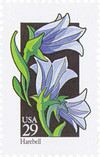
# 2689 - 1992 29c Wildflowers: Harebell
US #2689
1992 Harebell
- Part of the Wildflowers pane of 50 stamps
- Fourth pane of 50 different stamps issued by the USPS
- First 50-stamp pane printed by a private contractor.
- First US commemorative issue printed completely by offset lithography
Stamp Category: Commemorative
Set: Wildflowers
Value: 29¢, the First-Class Mail Rate
First Day of Issue: July 24, 1992
First Day City: Columbus, Ohio
Quantity Issued: 11,000,000
Printed by: Ashton-Potter America, Inc.
Printing Method: Offset
Format: Printing plates of 300 (30 across, 10 down) and 200 (20 across, 10 down), separated into panes of 50 (10 across, 5 down)
Perforations: 11
Why the stamp was issued: This pane was issued to highlight wildflowers native to the United States.
About the stamp design: The watercolor painting of the Harebell was produced by Karen Mallary. The scientific name for the flower is Campanula rotundifolia. Its common names include Scottish bluebell or bluebell of Scotland. This plant is native to temperate regions of the northern hemisphere, including most of the US. As the name suggests, the flowers bloom in a bell shape.
The 50 wildflowers on the pane this stamp is part of are all native to the US and can be found in at least one of the 50 stamps. Alaska watercolor artist Karen Mallary was assigned to the task of choosing the flowers and illustrating them.
About the printing process: Printed by Ashton-Potter America Inc, the pane was the first 50-stamp pane printed by a private contractor. It was the first US commemorative stamp issue produced by offset lithography. The USPS was concerned that offset printing would not provide security against counterfeiting but realized other measures, such as tagging, would provide additional security. This was also the first US issue to be printed on 200-subject and 300-subject plates. The selvage of each pane has a diagram showing the position of that pane on the printing plate.
First Day City: The First Day of Issue ceremony took place during the American First Day Cover Society convention held in Columbus, Ohio. Karen Mallary, the artist behind these stamps, attended the ceremony.
Unusual fact about this stamp: The Wildflowers stamps were sold in some locations before the official First Day of Issue. Postmarks have been found with dates up to six weeks before.
US #2689
1992 Harebell
- Part of the Wildflowers pane of 50 stamps
- Fourth pane of 50 different stamps issued by the USPS
- First 50-stamp pane printed by a private contractor.
- First US commemorative issue printed completely by offset lithography
Stamp Category: Commemorative
Set: Wildflowers
Value: 29¢, the First-Class Mail Rate
First Day of Issue: July 24, 1992
First Day City: Columbus, Ohio
Quantity Issued: 11,000,000
Printed by: Ashton-Potter America, Inc.
Printing Method: Offset
Format: Printing plates of 300 (30 across, 10 down) and 200 (20 across, 10 down), separated into panes of 50 (10 across, 5 down)
Perforations: 11
Why the stamp was issued: This pane was issued to highlight wildflowers native to the United States.
About the stamp design: The watercolor painting of the Harebell was produced by Karen Mallary. The scientific name for the flower is Campanula rotundifolia. Its common names include Scottish bluebell or bluebell of Scotland. This plant is native to temperate regions of the northern hemisphere, including most of the US. As the name suggests, the flowers bloom in a bell shape.
The 50 wildflowers on the pane this stamp is part of are all native to the US and can be found in at least one of the 50 stamps. Alaska watercolor artist Karen Mallary was assigned to the task of choosing the flowers and illustrating them.
About the printing process: Printed by Ashton-Potter America Inc, the pane was the first 50-stamp pane printed by a private contractor. It was the first US commemorative stamp issue produced by offset lithography. The USPS was concerned that offset printing would not provide security against counterfeiting but realized other measures, such as tagging, would provide additional security. This was also the first US issue to be printed on 200-subject and 300-subject plates. The selvage of each pane has a diagram showing the position of that pane on the printing plate.
First Day City: The First Day of Issue ceremony took place during the American First Day Cover Society convention held in Columbus, Ohio. Karen Mallary, the artist behind these stamps, attended the ceremony.
Unusual fact about this stamp: The Wildflowers stamps were sold in some locations before the official First Day of Issue. Postmarks have been found with dates up to six weeks before.


















